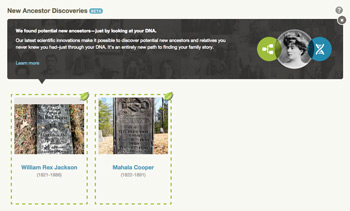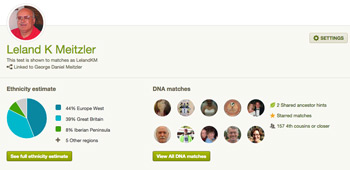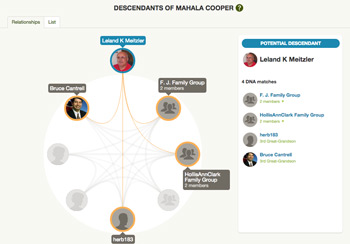
A few days ago, AncestryDNA launched a new program called New Ancestor Discoveries. I’ve been swamped with the editing of several new books and Insta-Guides that are about to launch at FRPC and have just now gotten time to check it out.
I got an email from Ancestry saying that I had matches in the new program. It seems that there’s a good chance (70% or better) I’m descended from or related to two folks I’d never heard of.
Based on DNA tests that I’ve had done with Ancestry, there are connections and online trees for 157 folks with whom I have a 4th cousin or better relationship. I recognize a lot of these folks, so the technology does work. We’ve come a long way in the 35 years since I started to actively research!
According to a note from my friend, Anna Swayne, with Ancestry DNA, the following points are what make this latest New Ancestor Discoveries technology exciting:
DNA Circles will now include anyone in your tree not only direct ancestral lines. For example, if you are genetically related to members of your 3rd great-granduncle’s DNA Circle and you have him in your tree we will now include you into that DNA Circle.
- DNA Circle graph is now included in all DNA Circles and New Ancestor Discoveries
- The orange lines represent DNA and the common ancestor connection between each individual in the DNA Circle
- The thickness of the lines are determined by the strength of the connection
We changed the way family groups are displayed in the DNA connection page
- If you belong to a family unit (family unit consists of 1st cousin relationships or closer) we will roll you up under the name of the most common ancestor.
- For example, you, and your three 1st cousins were tested we would wrap your “family unit” up under your grandparent in common and the display the name of that common ancestor.
The Ancestor Page is new to all DNA Circle members
- It is only accessible from the DNA Circle or New Ancestor Discovery experience
- Have an all access pass with a subscription to see photos, records, and facts about this particular ancestor
- Information from this page is compiled from public member trees
The following is the press release from Ancestry:
Latest Breakthrough in Consumer Genetics Connects People to Ancestors Dating Back to the 1700s Using Just Their DNA
PROVO, UT–(Marketwired – April 02, 2015) – AncestryDNA, the leader in DNA testing for family history, today launched a significant technological advancement that makes discovering one’s family history faster and easier than ever. Now with the easy-to-use AncestryDNA test, customers will have the unique ability to find their ancestors, who lived hundreds of years ago, using just their DNA. Only possible through the groundbreaking work of the AncestryDNA science team, New Ancestor Discoveries is a technical innovation that combines the latest in genetic science, new patent-pending algorithms, and access to AncestryDNA’s extensive database to push the boundaries of human genetics, and help people find ancestors from their past using just a DNA test, no genealogy research required.
“This is the biggest advancement in family history since we introduced our Hint feature, the Ancestry shaky leaf, which scours billions of historical records to automatically find new information about your family,” said Tim Sullivan CEO of Ancestry. “Now, through a simple DNA test, AncestryDNA is fundamentally revolutionizing the way to discover your family history, transforming the experience by making it faster and easier to go further into your family’s past, and instantly discover new ancestors you never knew you had.”
New Ancestor Discoveries are revealed through a unique combination of AncestryDNA results and the millions of family trees shared by Ancestry members. First, living cousins of each AncestryDNA member are found and organized into family networks, called DNA Circles, which bring together groups of people who are genetically related to the same ancestor. When a new AncestryDNA customer is connected into that DNA Circle, it’s likely they also share that same ancestor. As a result, it is now possible to simply take the AncestryDNA test and see the name of an ancestor from your family’s past appear in your DNA results.
“It is effectively a shortcut through time — you take the test today and we tell you who your ancestors were, for example, in the 1700s. You don’t need to research records or build a family tree — AncestryDNA now transports you to the past,” said Dr. Ken Chahine, SVP and GM of AncestryDNA. “It’s a combination of three things that allowed us to achieve this breakthrough innovation: 1) millions of family trees created by Ancestry members, 2) the fastest growing genetic database in the world, currently with more than 800,000 genotyped members and 3) a dedicated team of scientists who are pushing the boundaries of genetics and statistics to help people make family history discoveries in ways never before possible.”
Discovering new ancestors is made simple. Customers just provide a small saliva sample for the AncestryDNA test, which reads a person’s genetic code at more than 700,000 DNA markers. Mail it back where it will be analyzed and compared alongside 65 million family trees and more than 800,000 genotyped AncestryDNA members. Results are available within six to eight weeks, including new possible ancestors, accompanied by historical narratives of their lives that can include photos, locations, and life events available to Ancestry members.
With this latest innovation, AncestryDNA will open the door to a whole new segment of consumers that may be interested in family history but don’t know how or don’t have the time to search records or build a family tree. It will also meet the needs of experienced genealogists, who may need new genetic connections to their ancestors to help break through dead-ends in their research that historical records alone cannot.
AncestryDNA is now connecting people to ancestors from significant periods of time and from all around the world, including Colonial America, the UK, Ireland, Scotland, Germany, Poland, France, Spain, Denmark, Sweden, Norway, Italy and more. Extending beyond the initial discovery of these ancestors, with a subscription to Ancestry, members can dig into the rich story of those ancestors’ lives through historical documents, photos, and insights from the events that shaped the times in which they lived.
To learn more about the new AncestryDNA experience, visit www.ancestrydna.com.
About Ancestry.com DNA, LLC
About Ancestry.com DNA, LLC. AncestryDNA is owned and operated by Ancestry.com DNA, LLC, a subsidiary of Ancestry.com LLC. AncestryDNA uses a simple test to analyze an individual’s DNA. AncestryDNA offers the potential of identifying new insights into people’s ancient ancestry to help them collaborate with distant cousins and make even more discoveries in their family history. For more information visit www.ancestrydna.com.


Will my name and my husbands name be included in this new way of showing our relationships?
I kind of doubt that your names would show up in the trees, as obviously you are still living! But deceased ancestors very well could.
I just had you do my DNA. Will these new ties be sent to me?
It wasn’t me that did it! It was Ancestry. I just wrote about it – and yes, I’m sure they will…